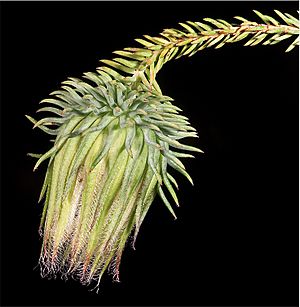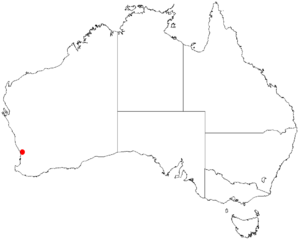Muchea bell facts for kids
Quick facts for kids Muchea bell |
|
|---|---|
 |
|
| The Muchea bell plant near Bullsbrook | |
| Conservation status | |
| Scientific classification | |
| Genus: |
Darwinia
|
| Species: |
foetida
|
 |
|
| Where the Muchea bell is found (data from AVH) | |
The Darwinia foetida, also known as the Muchea bell, is a special plant found only in Western Australia. It belongs to the myrtle family, called Myrtaceae. This small, upright shrub has greenish flowers that droop a bit at the end of its stems. These flowers have a strong, unpleasant smell, which is why its scientific name, foetida, means "smelly" in Latin. You can only find this plant in a few places.
Contents
What the Muchea Bell Looks Like
The Muchea bell is a shrub that grows up to about 0.7 meters (2 feet) tall. It often leans on other plants for support. Its young branches are green-brown and thin. As they get older, the parts where the leaves attach become grey and woody.
The leaves are green, smooth, and narrow. They are shaped like a triangle if you cut them in half. Each leaf is bent forward and is about 3 to 5 millimeters long, ending in a sharp point.
The plant usually has 12 to 15 flowers grouped together at the end of each stem. These flowers often nod downwards. Around the flowers are special leaf-like parts called bracts. They are arranged in rows and are wider at their base. Each flower has two long, dry, brown bracts that are about 2 to 3 millimeters long and get narrower at the end. The longest bracts are red with green edges and have hairs, growing to about 18 to 27 millimeters long.
The flowers themselves are brown and shaped like a tube, about 3 millimeters long with small ridges. The sepals (small leaf-like parts that protect the flower bud) are tiny triangles, about 1 millimeter long. The petals (the colorful parts of a flower) are egg-shaped or angled, about 1 millimeter long, and have a sharp tip. The red, curved style (a part of the flower that helps with reproduction) is wider at its base and about 12 to 16 millimeters long, tapering to a point with hairs.
The Muchea bell blooms in late spring, usually from October to November. Its green flowers have that distinctive smelly (foetid) aroma.
Naming the Muchea Bell
The scientific name Darwinia foetida was officially given to this plant in 2010. It was described by a scientist named Gregory John Keighery in a publication called the Australian Plant Census.
The second part of its name, foetida, comes from a Latin word that means "smelly." This refers to the strong, unpleasant smell that its flowers have.
Where the Muchea Bell Lives
The Muchea bell is found in a very small area called the Swan Coastal Plain in Western Australia. It has only been recorded in three spots around Muchea, which is about 70 kilometers (43 miles) north of Perth. The total area where it grows is very small, about 1.2 square kilometers (0.5 square miles).
This plant likes to grow on sandy, grey-black mounds. It prefers places that are wet in winter or have wet clay soil. You can find it in areas with tall or low scrubland, especially where water tends to collect.
Protecting the Muchea Bell
The Muchea bell is considered a very rare plant. The Australian Government lists it as "critically endangered" under the Environment Protection and Biodiversity Conservation Act 1999. This means it is at a very high risk of disappearing forever. In Western Australia, it is listed as "endangered" under the Biodiversity Conservation Act 2016.
Because it only grows in a small area around Muchea, it faces several threats:
- Grazing by rabbits: Rabbits eat the plants, which can stop them from growing and reproducing.
- Weed invasion: Other plants (weeds) can grow too close and take away water and nutrients that the Muchea bell needs.
- Inappropriate fire regimes: Fires that happen too often or at the wrong time can harm the plants.
- Disease: A plant disease caused by a fungus-like organism called Phytophthora cinnamomi can also make the plants sick and kill them.
Protecting these plants is very important to make sure they survive for future generations.


